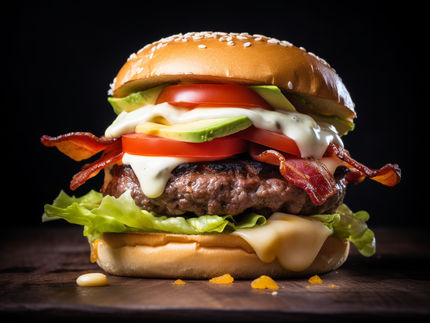I Eat What You Eat
When buying snacks, primary school children are often out and about with their peers - does this influence their purchasing decisions?
Do primary school children influence the snack purchases of their peers? A study by the University of Bonn reveals that they do indeed. In the presence of friends or classmates, kids are more likely to choose the unhealthier, but also the cheaper option. These findings can support policymaking aimed at motivating primary schoolers to make healthier choices. The study was recently published in the journal Appetite.
Whether during school breaktimes, at a kiosk on the way home, or at the swimming pool ... wherever and whenever school kids buy snacks on their own, they tend to be in the company of their peers. The question of how their purchasing decisions are thereby influenced is of interest, not least because one in seven children between the ages of six and twelve in Germany today is overweight. This is not a trivial matter, as being overweight can lead to diabetes, cardiovascular diseases and other serious long-term health consequences. “Even at primary school age, children often possess considerable purchasing power, thanks to their allowances and cash gifts. This allows them to make personal choices such as buying snacks on their own,” notes Stefanie Landwehr, doctoral student at the Chair for Agricultural and Food Market Research at the University of Bonn. “To support children in making the healthier choice, it is important to understand the determinants that influence their purchasing decisions,” she explains. While there is scientific evidence that eating behavior of children is influenced by the presence of their peers, no study yet examined how the presence of peers affects children’s purchasing decisions.
To address this question, Landwehr designed this study together with Professor Monika Hartmann, head of the department of Agricultural and Food Market Research at the Institute for Food and Resource Economics at the University of Bonn. For their study, they recruited approximately 130 third and fourth graders between the ages of eight and ten. Initially, the kids completed a child-friendly questionnaire that inquired about their snack preferences and their knowledge of nutrition, for example asking: “If a product has a high sugar content, is that good for me?” Subsequently, they were given another task designed to measure their problem-solving skills. As a reward for participating up to this point, the children received three euros.
Part of this money they could use in a simple purchasing experiment. They were given these snack options to choose from: chocolate cookies (the unhealthiest choice), fruit puree in pouches, called Quetschies, (second-healthiest choice) and apple slices (healthiest choice). The children could choose between branded products from McDonald’s and no-name products. The third criterion was the price: the snacks were available at 0.60 Euro, 1.00 Euro,1.40 Euro.
The kids now had the opportunity to choose between two products, for example, a small bag of apple slices from McDonald’s for 1.00 Euro and a no-name Quetschie for 0.60 Euro. Alternatively, they could decide not to purchase either of the snacks. Their choice was recorded on a response card. This selection process was repeated a total of ten times with different snack, brand and price combinations. In the end, each child was allowed to randomly draw one card from the ten response cards, and the choice recorded on that card was implemented. This means that the child received the corresponding snack and had to pay the price indicated on the card. If the drawn response card indicated that the child had chosen not to have any snack, the child received no snack and was not required to pay anything. The procedure had been explained to the children with an example before the start of the experiment, so they were aware that one of their decisions would be randomly chosen and ‘binding’.
Before the experiment began, the children were randomly assigned to one of two groups: in one group, they individually participated in the purchase experiment, while in the other group, they were paired with another child of the same age. Even in the second group, each child had to make their own choice. However, in this group, children were allowed to discuss their decisions with each other before making their choices.
The analysis of the results indicates that conformity seems to play a significant role in this age group: “When the children purchased snacks in the presence of a friend, they often made the same decision. In 13.5 percent of cases, both children even consistently chose the same snacks in all ten rounds,” explains Hartmann. They tended to choose the chocolate cookie, the least healthy option, particularly frequently. In contrast, children who participated in the experiment by themselves more often opted for the Quetschies. “One possible explanation for these differences between the two groups could be that children assume their peers might view cookies as “cooler” or more esteemed among their peers – perhaps even because they are less healthy,” speculates Hartmann.
Even children with a high level of knowledge about nutrition often made the same decision as their partners. “Interestingly, children in the second group more frequently decided not to purchase either of the two snacks. “It seems that the desire for conformity led to these decisions despite different preferences,” postulates Landwehr. A positive observation related to this “peer pressure”: children tended to choose more budget friendly options when in the presence of another child, thus, demonstrating greater price awareness.
One criterion that played almost no role in childrens’ buying decisions was the brand. Although the children expressed that they liked McDonald’s, products from this brand were chosen less frequently. “Cookies, Quetschies, and apple slices are not products that children typically associate with McDonald’s, which is why the brand does not play a decisive role in this case,” assumes Hartmann.
The results of the study provide new insights for health policies: “Campaigns promoting healthy eating should take into account that children influence the purchasing behavior of their peers,” notes Landwehr. This could be achieved, for example, through informational campaigns in which children play a central role. “The campaigns should not only emphasize the benefits of healthy snacks but also convey that the healthier alternatives are also the ‘cooler’ ones,” Landwehr adds. At the same time, increasing the prices of less healthy snacks, for instance, in a school setting, could be an effective measure.






























































